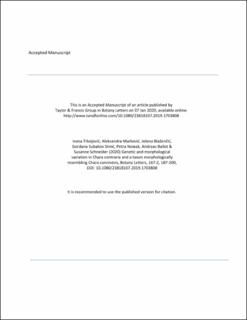| dc.contributor.author | Trbojević, Ivana | |
| dc.contributor.author | Marković, Aleksandra | |
| dc.contributor.author | Blaženčić, Jelena | |
| dc.contributor.author | Subakov Simić, Gordana | |
| dc.contributor.author | Nowak, Petra | |
| dc.contributor.author | Ballot, Andreas | |
| dc.contributor.author | Schneider, Susanne Claudia | |
| dc.date.accessioned | 2020-08-12T11:37:10Z | |
| dc.date.available | 2020-08-12T11:37:10Z | |
| dc.date.created | 2020-04-18T15:32:03Z | |
| dc.date.issued | 2020 | |
| dc.identifier.citation | Botany Letters. 2020, 167 (2), 187-200. | en_US |
| dc.identifier.issn | 2381-8107 | |
| dc.identifier.uri | https://hdl.handle.net/11250/2671740 | |
| dc.description | Embargo until 07 January 2021 | en_US |
| dc.description.abstract | Charophyte species delineation is regularly based on a set of thallus morphological characteristics, but considering pronounced phenotypic plasticity, difficulties and doubts commonly occur in Chara species determination. DNA barcoding may contribute to solving these challenges. Here we characterize Chara contraria with an unusual set of morphological characteristics, and specimens morphologically resembling Chara connivens collected in Serbia, by describing their morphological traits and analysing matK barcoding results. Our results indicated that dioecious Chara specimens, tentatively determined as Chara “connivens” based on morphological traits, were genetically more closely related to C. globularis. These Chara “connivens” specimens formed a sister group to a monophyletic C. globularis cluster, suggesting that it may be neither C. connivens nor C. globularis. We strongly encourage further barcoding of C. “connivens” samples from freshwater, in order to find out if there are consistent genetic differences between the dioecious freshwater C. “connivens” and monoecious C. globularis. Barcoding of matK placed the monoecious Chara specimens, which based on morphological characteristics initially were determined as C. virgata, into the C. contraria group. This indicates that the microscopic traits which commonly are used for Chara species determination sometimes are misleading. In general, our study challenges the commonly used phenetic species concept in Charophyte taxonomy and illustrates the importance of molecular approaches to evaluate the validity of morphological characteristics of the plant thallus in species delineation. | en_US |
| dc.language.iso | eng | en_US |
| dc.publisher | Taylor & Francis | en_US |
| dc.title | Genetic and morphological variation in Chara contraria and a taxon morphologically resembling Chara connivens | en_US |
| dc.type | Peer reviewed | en_US |
| dc.type | Journal article | en_US |
| dc.description.version | acceptedVersion | en_US |
| dc.source.pagenumber | 187-200 | en_US |
| dc.source.volume | 167 | en_US |
| dc.source.journal | Botany Letters | en_US |
| dc.source.issue | 2 | en_US |
| dc.identifier.doi | 10.1080/23818107.2019.1703808 | |
| dc.identifier.cristin | 1806931 | |
| cristin.ispublished | true | |
| cristin.fulltext | postprint | |
| cristin.qualitycode | 1 | |
